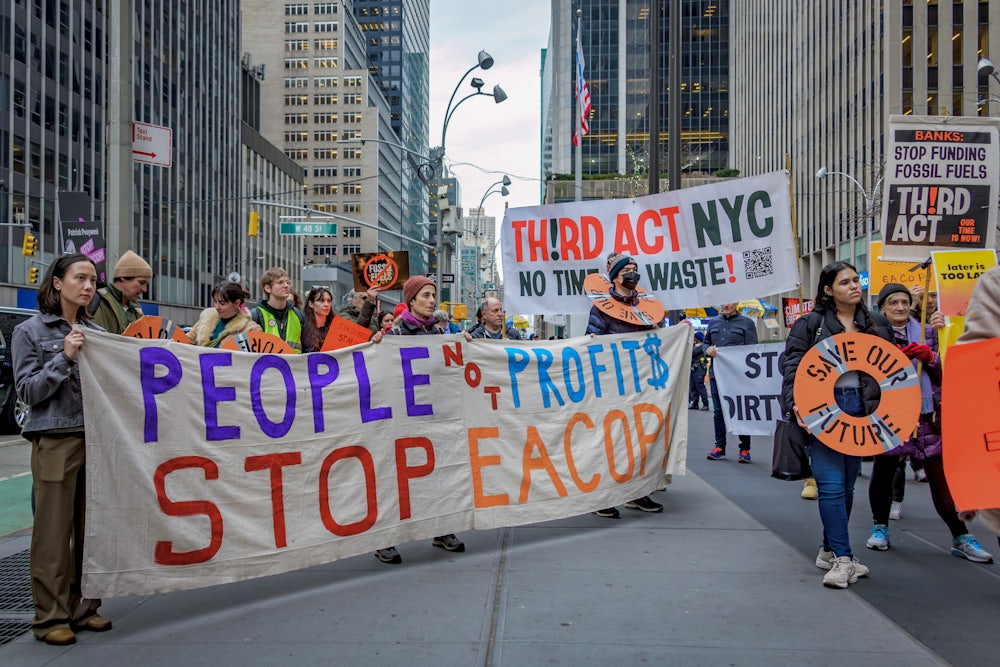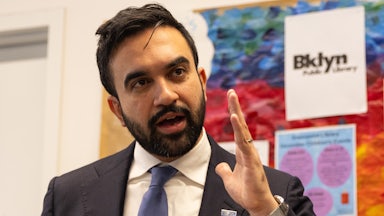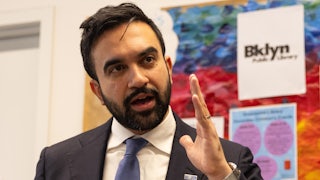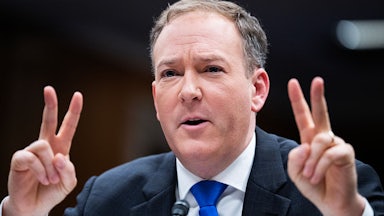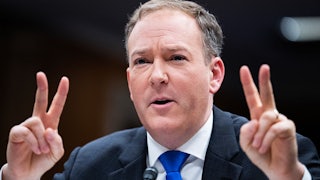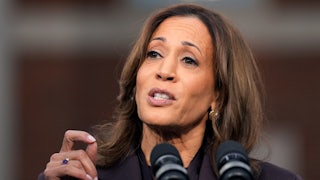The battle to define what went wrong for Democrats in the election, and chart a path out of the wilderness, is well underway. Trump’s campaign successfully courted working-class voters with stories attributing their pain to clearly defined villains—immigrants, transgender people, failing institutions, social elites—that Trump promised to take on. To beat this MAGA populism, prominent Democrats have begun urging their party to adopt similarly populist postures but with a different set of villains—the economic elites and rapacious corporations that are actually making the lives of working people harder.
Leftists aren’t the only ones urging Democrats to go populist. No less an embodiment of the centrist ethos than David Brooks proposed that “maybe the Democrats have to embrace a Bernie Sanders-style disruption—something that will make people like me uncomfortable.” James Carville lamented that Democrats didn’t run with Bernie’s populist issues “more front and center.” Congressman Pat Ryan, a swing-seat Democrat from New York, put it this way: “It’s about who fights for the people vs. who further empowers and enables the elites.”
If this emerging logic is critical to Democrats’ future prospects, it is doubly important for the climate movement. The way Democratic leaders have framed climate change over the last four years—as an opportunity for green jobs and industrial policy—was not the electoral winner many had hoped. Indeed, Kamala Harris’s campaign treated climate change as a political liability to be avoided, not a politically advantageous fight to play up.
And yet, if Democrats are looking for issues and villains that demonstrate which party fights for the people versus which one further empowers and enables the elites, the climate crisis actually provides one of our strongest playing fields. After all, Big Oil executives are villains straight out of central casting. We’re talking about millionaire and billionaire elites who price-gouged consumers, lining their pockets with outrageous profits while raising costs on regular people. They created the plastic pollution crisis, defrauding the American public about the recyclability of their toxic products (an issue of great resonance to Robert F. Kennedy Jr. and other wellness-focused voters who swung toward Trump).
And, of course, they knowingly caused climate change, predicting decades ago and with stunning accuracy that their fossil fuel products would have, in their own words, “catastrophic” climate effects that would do “great irreversible harm,” create “more violent weather—more storms, more droughts, more deluges,” and cause “suffering and death due to thermal extremes.” Instead of finding new business models or at least issuing warnings about the dangerousness of their products, Big Oil companies waged a massive disinformation campaign to prevent the public from understanding the risks of climate change. They made trillions of dollars from this deception, leaving regular Americans to pay the price.
And boy, are regular Americans paying the price. They’re paying in higher insurance costs driven by the “violent weather” that Big Oil companies knew their products would cause. They’re paying in homes, businesses, and livelihoods lost in climate-driven “deluges,” from North Carolina to Vermont to New Mexico and everywhere in between. And, most tragically of all, they’re paying with their lives—over 200 killed recently by Hurricane Helene, over 600 killed by “thermal extremes” in Maricopa County in each of the last two years, similar numbers lost in the Pacific Heat Dome several summers ago, and the list goes on and on. These tragedies did not just happen; in many cases, according to climate attribution scientists, they would have been “virtually impossible” but for climate change—just as Big Oil predicted.
This suffering and death is incomparable to any harm that can be even remotely attributed to immigrants or the other “villains” of Trump’s right-wing populism. But here’s the thing—stories don’t tell themselves. Neither Democrats nor many of the larger groups making up the climate movement have ever primarily framed climate as a struggle between the elites who disproportionately created the crisis and the regular people living through its consequences. For many years, the dominant rallying cry among climate activists was “keep it in the ground,” a message targeting fossil fuels themselves, not the lying executives profiting off them. Then the focus shifted to climate jobs, from the left’s “Green New Deal” to the Biden administration’s green industrial policy—a narrative that eschewed villains entirely.
As we enter a new political era, both the climate movement and the Democratic Party need to embrace a new approach to climate change: climate populism. Climate populism focuses less on the macroeconomics of a clean energy transition and more on the severe physical and pocketbook harms caused by Big Oil executives, both through their fleecing of consumers and their fraudulent disinformation campaigns, which are directly connected to the lethal heat waves, devastating wildfires, catastrophic floods, and wallet-busting insurance crises harming hundreds of millions of Americans every year.
Climate populism covers a range of programs—like a windfall profits tax to curb Big Oil price gouging, climate superfund legislation to make polluters pay for their destructive conduct, and increasing investigations into and accountability for Big Oil’s lies and deception. It positions climate solutions like solar panels and distributed generation as tools to lower prices and stick it to utilities. And it calls out proposals like the push to increase liquefied natural gas exports because they raise energy costs for working people.
But more than any one policy, climate populism is a narrative and posture. Rather than run from climate conversations, Democrats looking to prove they’re on the side of the people rather than the elites should shout with one voice every time a community is poisoned by pollution or a climate disaster leaves a family homeless or an insurer pulls out of a fire- or flood-prone state: “Look what these fossil fuel fat cats are doing to you! Look how the Big Oil executives responsible for this mess are living it up in their mansions and private jets, sucking up billions of your tax dollars in public subsidies, and pulling the strings of this corrupt administration that would rather give away the store to its fossil fuel donors than stand up for you and your neighbors!”
After summarizing his populist strategy for winning an easy reelection in one of the toughest districts in the country, Congressman Pat Ryan provided a great example of how climate can fit into and strengthen a populist approach. Ryan explained the importance of naming “the billionaires and big corporations making record-breaking profits while the rest of us struggle.” He listed various ways he communicated this message: calling on a utility CEO to resign, going after Wall Street speculators, taking on Big Pharma. And then he wrote, “And yeah, I rallied with AOC for clean water and climate action.… If you want to say I’m a progressive for saying polluters should pay to clean up their mess, feel free. I don’t give a sh*t about labels. I care about delivering for my constituents and my community.”
Over the next four years, Americans will experience an accelerating barrage of climate disasters, both physical and economic, that will make countless working people materially worse off. These voters are going to be angry, and rightfully so. If the only explanation they’re offered for their pain is Trump’s MAGA worldview, that’s the story they’ll accept.
But there’s another story, a truer story—one of corporate conspiracy and rapacious profiteering—that has the potential to be even more compelling. It should be the top priority of every climate organization, advocate, and commentator to tell that story, to name those villains, at every turn and across every medium. And rather than run from climate issues, as Harris’s campaign did, Democrats should embrace any opportunity they get to attack the corruption of Big Oil, proving that it is their party, not Trump’s, that “fights for the people.”
